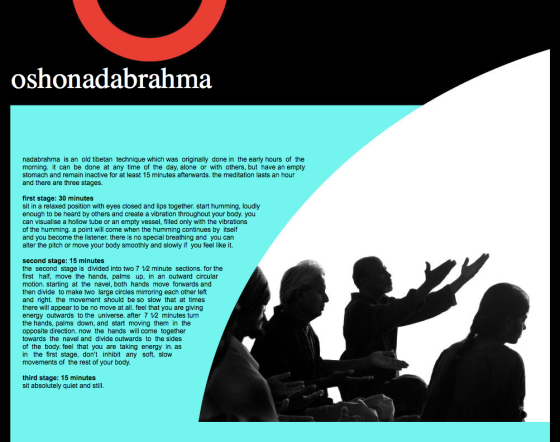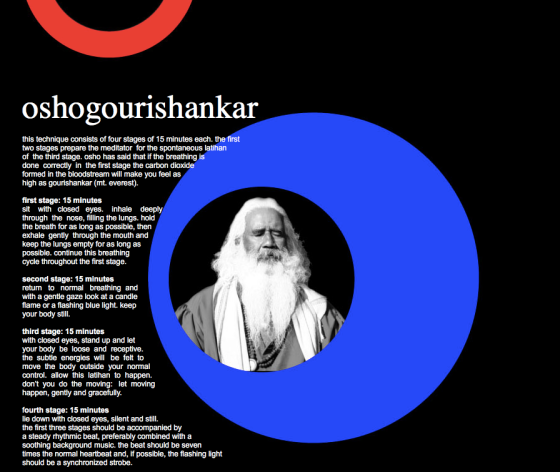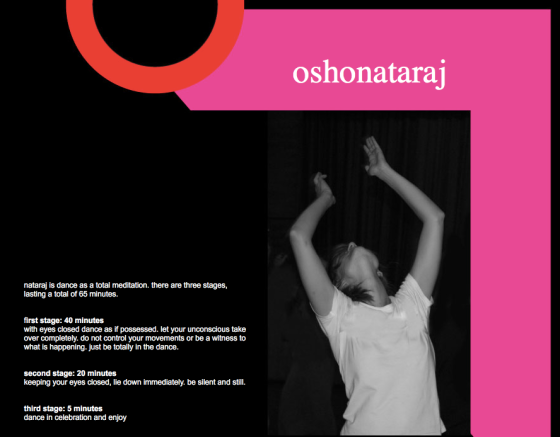ओशो नाद ब्रह्म ध्यान
नाद ब्रह्म एक प्राचीन तिब्बती विधि है जिसे सुबह ब्रह्ममुहूर्त में किया जाता रहा है। अब इसे दिन में किसी भी समय अकेले या अन्य लोगों के साथ किया जा सकता है। पेट खाली होना चाहिए और इस ध्यान के बाद पंद्रह मिनट तक विश्राम करना जरूरी है। यह ध्यान एक घंटे का है और इसके तीन चरण है।
पहला चरण: तीस मिनट
एक विश्राम पूर्ण मुद्रा में आँख और मुंह बंद करके बैठे। अब भौंरे की तरह गुंजार की ध्वनि निकालना शुरू करें। गुंजार इतना तीव्र हो की तुम्हारे आस पास बैठे लोगों को यह सुनाई पड़ सकें और गुंजार की ध्वनि के कंपन तुम्हारे पूरे शरीर में फैल सकें। स्वयं को एक खाली पात्र या खोखले टयूब की तरह कल्पना करो जो गुंजार की ध्वनि से भर गई हो। एक स्थिति ऐसी आती है जब गुंजार अपने आप जारी रहता है और तुम एक श्रोता मात्र हो जाते हो। इस विधि में किसी विशेष श्वसन प्रक्रिया की जरूरत नहीं है, और तुम गुंजार की लय को बदल भी सकते हो, तथा लगे तो शरीर को धीरे-धीरे झूमने दे सकते हो।
दूसरा चरण: पंद्रह मिनट
दूसरा चरण साढ़े सात-सात मिनट के दो भागों में बटा हुआ है। पहले साढ़े सात मिनट में दोनों हथैलियां आकाशोन्मुखी फैला कर नाभि के पास से आगे की और बढ़ाते हुए चक्राकार घुमाएं। दायां हाथ दायी और बायां हाथ बायी और चक्राकार घुमाएं। और तब वर्तुल पूरा करते हुए दोनों हथेलियों को पूर्ववत नाभि के सामने वापस ले आएं। यह गति साढ़े सात मिनट तक जारी रखें। गति इतनी धीमी हो कि कई बार तो ऐसा लगेगा कि कोई गति ही नहीं हो रही है। भाव करें कि आप अपनी ऊर्जा बाहर ब्रह्मांड में फैलने दे रहे है।
साढ़े सात मिनट के बाद हथेलियों को उलटा, भूमि उन्मुख कर लें और विपरीत दिशा में वृत्ताकार घुमाना शुरू करें। अब फैले हुए हाथ नाभि की और वापस आएँगे। फिर पेट के किनारे से बाहर वृत बनाते हुए बाजुओं में फैल कर फिर वृत को पूरा करते हुए नाभि की और वापस लौटेंगे। अनुभव करो कि तुम ऊर्जा भीतर ग्रहण कर रहे हो। पहले चरण की तरह शरीर में यदि कोई धीमी गति हो तो उसे रोकें मत, होने दें।
तीसरा चरण: पंद्रह मिनट
शांत और थिर होकर बैठे रहें या लेटे जाये।
दूसरी विधि: स्त्री-पुरूष जोड़ों के लिए नाद ब्रह्म ध्यान—
ओशो ने इस विधि का एक भिन्न रूप जोड़ों के लिए दिया है। स्त्री और पुरूष आमने सामने बैठ जायें। और अपने हाथ क्रॉस करके एक दूसरे के हाथों को पकड ले। फिर पूरे शरीर को एक बड़े कपड़ से ढंक लेते है। यदि वे निर्वस्त्र हो तो और भी अच्छा होगा। कमरे में मंद प्रकाश जैसे छोटी-छोटी चार मोमबत्तियाँ जल रही हों। केवल एक ध्यान के लिए अलग से रखी एक अगरबत्ती का उपयोग कर सकते है।
आंखे बंद कर लें और तीस मिनट तक एक साथ, भौंरे की गुंजार करें। कुछ ही समय में महसूस होगा की ऊर्जा एक दूसरे में मिल रही है।
(दूसरे और तीसरे चरण में साढ़े सात-सात मिनट के चरण में। पहले स्त्री भाव करे की उसकी उर्जा पुरूष में भर रही है, बह रही है, वह खाली हो रही है।
और तीसरे चरण में पुरूष भाव करे की उसकी ऊर्जा उसके साथ में भर रही हो और वह खाली हो रहा है। और ध्यान रहे जिस समय ऊर्जा एक दूसरे साधक के शरीर में बह रही हो तो पहला अपने आप को आस्तित्व के सहारे छोड़ दे अपने शरीर पर अपना अधिकार अपनी पकड़ छोड़ दे, अपने होने को छोड़ दे। नहीं तो ऊर्जा का वर्तुल टुट जायेगा। जब स्त्री पुरूष की ऊर्जा का विलय एक दूसरे में होगा। तब असीम आनंद बरसने लग जायेगा। एक महा मिलन का समय होगा वह। पति पत्नी के लिए ये खास ध्यान है। अगर जोड़ा इस ध्यान को करे तो उनका प्रेम बहुत गहरा हो सकता है। उनका अन्तस शरीर जो वो चाह कर भी कभी नहीं मिला सकते इन खुले क्षणों में मिल सकता है।)
(इस ध्यान के लिए आप एक अगरबत्ती का उपयोग कर सकते ‘’रत्नमाला’’ जो आपको कहीं भी मिल सकती है। ये में अपने अनुभव से आपको कह रहा हूं ओशो जी का ऐसी कोई राय नहीं है)
Tibetan Humming Meditation
Nadabrahma Meditation is a one hour technique in three stages, that was adapted from an ancient tibetan method.It can be done any time of the day or night, alone or with others. It is good to do this technique with an empty stomach.
THE INSTRUCTIONS
1st Stage 30 minutes Sit in a relaxed position with eyes closed and lips together. Start humming, loudly enough to be heard. Feel the humming resonate throughout your body and fall in tune with its vibration.
2nd Stage 15 minutes (7 1/2 + 7 1/2) Palms upwards start moving your hands forward from the belly. Then separate them so they circle outwards until they come back together at the belly. Continue with this movement. The movement should be very slow, so that at times it appears as if there is no movement at all. Feel that you are giving energy out to the universe. After seven and a half minutes there is a little gap in the music to let you know that you can now turn your palms down and reverse the circular motion of your hands, so that they now divide and circle outwards sideways from the belly and come back together in front of it. Feel that you are receiving energy from the universe.
3rd Stage 15 minutes
Remain sitting or lie down absolutely quiet and still
NADABRAHMA for couples
There is a beautiful, tantric variation of this technique for couples.
Partners sit facing each other, covered by a bedsheet holding each others crossed hands.
It is best to wear no other clothing. Light the room only by four small candles and burn a particular incense, kept only for this meditation. Close your eyes and hum together for thirty minutes. After a short while the energies will be felt to meet, merge and unite.
Continue in the 2nd stage as explained above, while still facing each other under the sheet, then in the last stage lie down together and be still.
Osho speaks about the Nadabrahma meditation.
It is a mantra meditation, and mantra is one of the most potential ways. It is very simple yet tremendously effective, because when you chant a mantra or you chant a sound your body starts vibrating; your brain cells particularly start vibrating.
If rightly done your
whole brain becomes tremendously vibrant, and the whole body also. Once the body starts vibrating and your mind is already chanting, they both fall in a tune. A harmony – which is ordinarily never there – between the two. Your mind goes on its way, your body continues on its own. The body goes on eating, the mind goes on thinking.’ the body goes on walking on the road the mind is moving far away in the stars. They never meet – they both go on separate pathways, and that creates a split.
The basic schizophrenia is created because the body goes in one direction, the mind goes in another direction. And you are the third element – you are neither the body nor the mind, so you are pulled apart by these two. Half of your being is pulled by the body and half of your being is pulled by your mind. So there is great anguish – one feels torn apart.
In a mantra meditation – Nadabrahma or any chanting – this is how the mechanism works: when you start chanting a sound – and any sound will do; even abracadabra – if you start resounding inside, the body starts responding. Sooner or later a moment comes when the body and the mind are both together in one direction for the first time. When body and mind are both together, you are free from the body and the mind – you are not tom apart. Then the third element which you are in reality – call it soul, spirit,’ atma’, anything – that third element is at ease because it is not being pulled in different directions.
The body and the mind are so much engrossed in chanting that the soul can slip out of them very easily, unobserved, and can become a witness – can stand out and look at the whole game that is going on between the mind and the body. It is such a beautiful rhythm that the mind and body never become aware that the soul has slipped out… because they don’t allow so easily, mm? they keep their possession. Nobody wants to lose his possession. The body wants to dominate the soul, the mind wants to dominate the soul.
This is a very sly way to get out of their hold. They become drunk with the chanting, and you slip out. So in Nadabrahma, remember this: let the body and mind be totally together, but remember that you have to become a witness. Get out of them, easily, slowly, from the back door, with no fight, with no struggle. Mm? they are drinking – you get out, and watch from the outside….
This is the meaning of the English word ‘ecstasy’ – to stand out. Stand out and watch from there… and it is tremendously peaceful. It is silence, it is bliss, it is benediction.
This is the whole secret of chanting – that’s why chanting has prevailed down the centuries. There has never been a religion that has not used chanting and mantra. But there is a danger also! If you don’t get out, if you don’t become a witness, there is a danger – then you have missed the whole point. If you become drunk with the body and the mind and your soul also becomes drunk, then chanting is an intoxicant. Then it is like a tranquiliser – it will give you a good sleep, that’s all. It is a lullaby. Good – nothing wrong in it – but not of any real value either.
So this is the pitfall to be remembered: chanting is so beautiful that one wants to get lost. If you are lost, then good, you enjoyed a rhythm, an inner rhythm, and it was beautiful and you liked it, but it was like a drug – it is an acid trip. By chanting, by the sound, you created certain drugs in your body. Chanting creates chemical changes in the body, and those changes are no different than marijuana or LSD. Some day, when research goes deeper into meditation, they are going to find that chanting creates chemical changes – just as fasting also creates chemical changes. After the seventh or eighth day of fasting, one feels tremendously jubilant, weightless, very glad for no reason, delighted – as if all burden has disappeared. Your body is creating a certain chemical change.
I am as much against LSD as I am against fasting. And if chanting is used as a drug, I am against it. So the point to be remembered is that you have to use the sound, the chanting, the mantra, not as an intoxicant for your being. Let it be an intoxicant for the body and the mind but you slip out of it before you become intoxicated; you stand out and you watch. You see the body swaying and you see the mind feeling very very peaceful and calm and quiet. Watch from the outside and be alert like a flame.
If this is not done you will have a good sleep but nothing more. Then it is a good thing for health but nothing for the ultimate growth. Good – pay attention to Nadabrahma, mm? And sometimes sitting silently, start chanting anything, ‘aum’, will do, or choose anything, any word, and get in tune with it. Meaning is not important: it can be meaningless – it can be meaningful. ‘Aum’ has no meaning. Or you can create your own mantra and chant it. But remember to slip out of it.
Let the body get drunk, let the mind get drunk, let them fall into a deep love-affair with each other, and you slip out of it. Don’t stay there longer – otherwise you will fall asleep. And if one falls asleep, it is not meditation. Meditation means awareness. So remember it!
Osho




